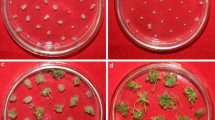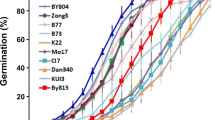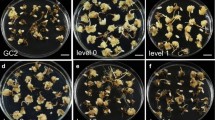Abstract
Induction of embryogenic callus in culture is an important step in plant transformation procedures, but response is genotype specific and the genetics of the trait are not well understood. Quantitative trait loci (QTL) were mapped in a set of 126 recombinant inbred lines (RILs) of inbred H99 (high Type I callus response) by inbred Mo17 (low Type I callus response) that were evaluated over two years for Type I callus response. QTL were observed in a total of eleven bins on eight chromosomes, including eight QTL with main effects and three epistatic interactions. Many of the QTL were mapped to the same or bordering chromosomal bins as candidate genes for abscisic acid metabolism, indicating a possible role for the hormone in the induction of embryogenic callus, as has previously been indicated in microspore embryo induction. Further examinations of allelic variability for known candidate genes located near the observed QTL could be useful for expanding the understanding of the genetic basis of induction embryogenic callus. The QTL observed herein could also be used in a marker assisted selection (MAS) program to improve the response of agronomically useful inbreds, but only if the resources required for MAS are lower than those required for phenotypic selection.



Similar content being viewed by others
References
Armstrong CL, Romero-Severson J, Hodges TK (1992) Improved tissue culture response of an elite maize inbred through backcross breeding, and identification of chromosomal regions important for regeneration by RFLP analysis. Theor Appl Genet 84:755–762
Austin DF, Lee M (1996) Comparative mapping in F2:3 and F6:7 generations of quantitative trait loci for grain yield and yield components in maize. Theor Appl Genet 92:817–826
Austin DF, Lee M (1998) Detection of quantitative trait loci for grain yield and yield components in maize across generations in stress and nonstress environments. Crop Sci 38:1296–1308
Austin DF, Lee M, Veldboom LR, Hallauer AR (2000) Genetic mapping in maize with hybrid progeny across testers and generations: grain yield and grain moisture. Crop Sci 40:30–39
Beaumont VH, Rocheford TR, Widholm JM (1995) Mapping the anther culture response genes in maize (Zea mays L.). Genome 38:968–975
Beckert M, Qing CM (1984) Results of a diallele trial and a breeding experiment for in vitro aptitude in maize. Theor Appl Genet 68:247–251
Caravalho CHS, Bohorova N, Bordallo PN, Abreu LL, Valicente FH, Bressan W, Paiva E (1997) Type II callus production and plant regeneration in tropical maize genotypes. Plant Cell Rep 17:73–76
Cardinal A, Lee M, Moore KJ (2003) Genetic mapping and analysis of quantitative trait loci (QTL) affecting fiber and lignin content in maize. Theor Appl Genet 106:866–874
Cowen NM, Johnson CD, Armstrong K, Miller M, Woosley A, Pescitelli S, Skokut M, Belmar S, Petolino JF (1992) Mapping genes controlling in vitro androgenesis in maize using RFLP analysis. Theor Appl Genet 84:720–724
Duncan DR, Willams ME, Zehr BE, Widholm JM (1985) The production of callus capable of plant regeneration from immature embryos of numerous Zea mays genotypes. Planta 165:322–332
Duncan DR, Kriz AL, Paiva R, Widholm JM (2003) Globulin-1 gene expression in regenerable Zea mays (maize) callus. Plant Cell Rep 21:684–689
Fehr WR (ed) (1987) Principles of cultivar development, vol. I: Theory and technique. McGraw-Hill, NY
Fransz PF, de Ruijter NCA, Schel JHN (1989) Isozymes as biochemical and cytochemical markers in embryogenic callus cultures of maize (Zea mays L.). Plant Cell Rep 8:67–70
Green CE, Phillips RL (1975) Plant regeneration from tissue cultures of maize. Crop Sci 15:417–421
Green CE, Rhodes CA (1982) Plant regeneration in tissue cultures of maize. In: Sheridan WF (eds) Maize for biological research. Plant Molecular Biology Association, Charlottesville, pp. 367–372
Hodges TK, Kamo KK, Becwar MR, Schroll S (1985) Regeneration of maize. In: Zaitlin M, Day P, Hollaender A, Wilson C (eds) Biotechnology in plant science: relevance to agriculture in the eighties. Academic, Orlando, pp. 15–33
Hodges TK, Kamo KK, Imbrie CW, Becwar MR (1986) Genotype specificity of somatic embryogenesis and regeneration in maize. Biotechnology 4:219–223
Holland JB (1998) EPISTACY: A SAS program for detecting two-locus epistatic interactions using genetic marker information. J Hered 89:374–375
Holland JB, Moser HS, O’Donoughue LS, Lee M (1997) QTLs and epistasis associated with vernalization responses in oat. Crop Sci 38:1306–1316
Knapp SJ, Stroup WW, Ross WM (1985) Exact confidence intervals for heritability on a progeny mean basis. Crop Sci 25:192–194
Krakowsky MD, Lee M, Woodman-Clikeman WL, Long MJ, Sharpova N (2004) QTL mapping of resistance to stalk tunneling by the European corn borer in RILs of maize population B73 × De811. Crop Sci 44:274–282
Lande R, Thompson R (1990) Efficiency of marker-assisted selection in the improvement of quantitative traits. Genetics 124:743–756
Lu C, Vasil K, Ozias-Akins P (1982) Somatic embryogenesis in Zea mays L. Theor Appl Genet 62:109–112
Marhic A, Antoine-Michaud S, Bordes J, Pollacsek M, Murigneux A, Beckert M (1998) Genetic improvement of anther culture response in maize: relationships with molecular, Mendelian, and agronomic traits. Theor Appl Genet 97:520–525
Murigneux A, Bentolila S, Hardy T, Baud S, Guitton C, Jullien H, Ben Tahar S, Freyssinet G, Beckert M (1994) Genotypic variation of quantitative trait loci controlling in vitro androgenesis in maize. Genome 37:970–976
Neill SJ, Horgan R, Parry AD (1986) The carotenoid and abscisic acid content of viviparous kernels and seedlings of Zea mays L. Planta 169:87–96
Papst C, Bohn M, Utz HF, Melchinger AE, Klein D, Eder J (2004) QTL mapping for European corn borer resistance (Ostrinia nubilalis Hb.), agronomic and forage quality traits of testcross progenies in early-maturing European maize (Zea mays L.) germplasm. Theor Appl Genet 108:1545–1554
Phillips RL, Somers DA, Hibberd KA (1988) Cell/tissue culture and in vitro manipulation. In: Sprague CF, Dudley JW (eds) Corn and corn improvement, 3rd edn. American Society of Agronomy Inc., Madison, WI pp. 245–288
Rao KV, Suprasanna P, Reddy GM (1990) Biochemical changes in embryogenic and non-embryogenic calli of Zea mays L. Plant Sci 66:127–130
Rawlings JO (1988) Applied regression analysis: a research tool. Wadsworth and Brooks, Pacific Grove, CA pp. 162–165
SAS Institute Inc (1999) SAS OnlineDoc®, Version 8. SAS Institute, Inc, Cary, NC
Tan BC, Schwartz SH, Zeevaart JAD, McCarty DR (1997) Genetic control of abscisic acid biosynthesis in maize. Proc Natl Acad Sci U.S.A. 94:12235–12240
Tomes DT (1985) Opportunities and limitations of the genotypic influences on establishment and plant regeneration from callus an cell cultures of crop species. In: Zaitlin M, Day P, Hollaender A, Wilson C (eds) Biotechnology in plant science: relevance to agriculture in the eighties. Academic, Orlando, FL pp. 3–14
Tomes DT, Smith OS (1985) The effect of parental genotype on initiation of embryogenic callus from elite maize (Zea mays L.) germplasm. Theor Appl Genet 70:505–509
Utz HF, Melchinger AE (1996) PLABQTL: a program for composite interval mapping of QTL. J Quant Trait Loci 2:1
Veldboom LR, Lee M, Woodman WL (1994) Molecular marker-facilitated studies in an elite maize population: I. Linkage analysis and determination of QTL for morphological traits. Theor Appl Genet 88:7–16
Wan Y, Rocheford TR, Widholm JM (1992) RFLP analysis to identify putative chromosomal regions involved in the anther culture response and callus formation in maize. Theor Appl Genet 85:360–365
Willman MR, Schroll SM, Hodges TK (1989) Inheritance of somatic embryogenesis and plantlet regeneration from primary (Type I) callus in maize. In Vitro Cell Dev Biol 25:95–100
Acknowledgments
This journal paper of the Iowa Agriculture and Home Economics Experiment Station, Ames, Iowa, Project No. 3134, was supported by Hatch Act and State of Iowa funds and The R. F. Baker Center for Plant Breeding.
Author information
Authors and Affiliations
Corresponding author
Additional information
Communicated by P. Langridge
Rights and permissions
About this article
Cite this article
Krakowsky, M.D., Lee, M., Garay, L. et al. Quantitative trait loci for callus initiation and totipotency in maize (Zea mays L.). Theor Appl Genet 113, 821–830 (2006). https://doi.org/10.1007/s00122-006-0334-y
Received:
Accepted:
Published:
Issue Date:
DOI: https://doi.org/10.1007/s00122-006-0334-y




